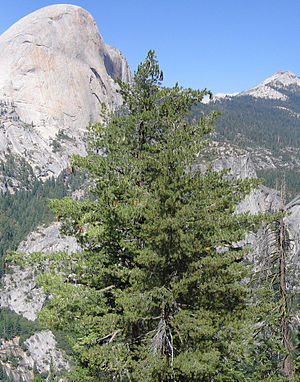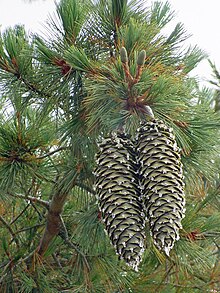Sugar pine
| Sugar pine | ||||||||||||
|---|---|---|---|---|---|---|---|---|---|---|---|---|

Sugar pine ( Pinus lambertiana ) at Half Dome in California |
||||||||||||
| Systematics | ||||||||||||
|
||||||||||||
| Scientific name | ||||||||||||
| Pinus lambertiana | ||||||||||||
| Dougl. |
The sugar pine ( Pinus lambertiana ) is a conifer from western North America. It is the largest of all pine species and also forms the longest cones of the genus. It gets its name from secretion drops that appear on the edges of the wound and taste sweet due to the high inositol content .
description
The sugar pine reaches a height of 60 meters, under optimal conditions a maximum height of 83 meters with a chest height diameter of 3 meters was measured. The maximum age is about 600 years. It has a straight trunk and a narrow, conical, open crown. The branches stand horizontally and are widely protruding to slightly overhanging. The bark of young trees is smooth and light brown, later it becomes thicker and split. Young shoots are thick and have short, soft, brown hairs. The red-brown buds are egg-shaped to cylindrical, 3 to 8 millimeters long, pointed and resinous and have close-fitting scales.
The needles sit in groups of five and are 7 to 10 centimeters long and 1.5 to 2 millimeters wide. They are dark green, stiff, somewhat twisted and sharply pointed and have a sawn edge. Inside they have bluish-white stomata lines . The needle sheaths are 2 inches long and obsolete. The needles stay on the tree for two to three years.
The male cones are yellow, cylindrical and 15 millimeters long. The seed cones ripen after two years. They are shiny light brown and are 30 to 60 centimeters long and 8 to 11 centimeters wide, when open up to 25 centimeters wide. They are cylindrical, stalked and drooping. The cone scales are leathery, broadly wedge-shaped and have a convex back and a blunt and slightly bent back tip. The seeds are 1.5 inches long and winged.
The number of chromosomes is 2n = 24.
Distribution and location requirements
The natural range of the sugar pine extends mainly over the precipitation-rich western slopes of the coastal mountains and the Sierra Nevada in California and Oregon . They are also found in western Nevada and northern Baja California .
It prefers cool, moist forests with permeable, fresh to moist, sandy and gravelly, moderately nutrient-rich soils. It grows on acidic to neutral soils and avoids calcareous substrates. They can be found at altitudes between 330 and 3,200 meters. It finds its optimum on deep, sandy loams made of weathered granite at heights between 1,500 and 2,000 meters. It is frost hardy and can withstand temperatures of −15 to −12 ° C. It thrives in sunny to light-shady locations.
The sugar pine is in the red list of the IUCN out as not at risk ( "Lower Risk / Least Concern"). It is pointed out, however, that a new check of the risk is necessary.
ecology
The sugar pine rarely occurs in pure stands. It grows together with the giant sequoia ( Sequoiadendron giganteum ), the Sierra fir ( Abies concolor var. Lowiana ), the frankincense cedar ( Calocedrus decurrens ), the Douglas fir ( Pseudotsuga menziesii ) and the yellow pine ( Pinus ponderosa ).
The species is severely damaged by the straw rust ( Cronartium ribicola ), which, however, occurs only rarely in the southern part of the range, possibly due to climatic causes. The general susceptibility to rust fungi and the insufficient frost resistance are reasons why it is not planted in Central Europe. The mountain pine beetle ( Dendroctonus ponderosae ) causes the greatest damage among the insects . When it is drought, other species such as the jewel beetle Melanophila californica or the bark beetle Dendroctonus valens also attack the sugar pine. The cones are damaged by the beetle Conophthorus lambertianae .
Systematics
The sugar pine is assigned to the Strobus subsection in the Quinquefoliae section . This is counted to the subgenus Strobus in the genus pines ( Pinus ). It can be crossed with the western white pine ( Pinus monticola ) and with Armand's pine ( Pinus armandii ).
Pinus lambertiana was first described in 1827 by the Scottish botanist David Douglas in the Transactions of the Linnean Society of London Volume 15, page 500. Synonyms are Picea lambertiana (Douglas) F.Sanders and Strobus lambertiana (Douglas) Moldenke .
use
The wood of the sugar pine is used extensively, with significantly more trees being cut down than they grow back. The wood can be split easily and was previously used to make shingles .
proof
literature
- Andreas Roloff , Andreas Bärtels: Flora of the woods. Purpose, properties and use. With a winter key from Bernd Schulz. 3rd, corrected edition. Eugen Ulmer, Stuttgart (Hohenheim) 2008, ISBN 978-3-8001-5614-6 , p. 767.
- Schütt, Schuck, Stimm: Lexicon of tree and shrub species . Nikol, Hamburg 2002, ISBN 3-933203-53-8 , pp. 364-365 .
Web links
- Christopher J. Earle: Pinus lambertiana. In: The Gymnosperm Database. conifers.org, accessed October 20, 2010 .
- Christoph Seidler: Survivor Trees in California: Hope for the super tree in: Der Spiegel from January 13, 2020.
Individual evidence
- ↑ a b c d e Pinus lambertiana. In: Flora of North America Vol. 2. www.eFloras.org, accessed January 30, 2010 .
- ↑ a b c Schütt et al .: Lexicon of Tree and Shrub Species , p. 365
- ↑ a b c d e Schütt et al .: Lexicon of Tree and Shrub Species , p. 364
- ↑ a b Roloff et al .: Flora of the Woods
- ↑ Elbert L. Little, Jr .: Pinus lambertiana. (pdf; 1.7 MB) In: Digital Representations of Tree Species Range Maps from "Atlas of United States Trees". US Department of Agriculture, Forest Service, accessed January 30, 2010 .
- ↑ a b Pinus lambertiana. Germplasm Resources Information Network (GRIN), accessed January 30, 2010 .
- ↑ Pinus lambertiana in the endangered Red List species the IUCN 2010. Posted by: Conifer Specialist Group, 1998. Retrieved on 3 January 2011th
- ^ RJ Habeck: Pinus lambertiana. In: Fire Effects Information System. US Department of Agriculture, Forest Service, 1992, accessed January 30, 2010 .
- ↑ a b Rafaël Govaerts (Ed.): Pinus. In: World Checklist of Selected Plant Families (WCSP) - The Board of Trustees of the Royal Botanic Gardens, Kew . Retrieved April 24, 2019.

